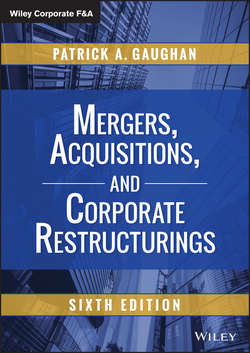Читать книгу Mergers, Acquisitions, and Corporate Restructurings - Gaughan Patrick А. - Страница 24
На сайте Литреса книга снята с продажи.
Part I
Background
Chapter 2
History of Mergers
What Causes Merger Waves?
ОглавлениеResearch has shown that merger waves tend to be caused by a combination of economic, regulatory, and technological shocks.15 The economic shock comes in the form of an economic expansion that motivates companies to expand to meet the rapidly growing aggregate demand in the economy. M&A is a faster form of expansion than internal, organic growth. Regulatory shocks can occur through the elimination of regulatory barriers that might have prevented corporate combinations. Examples include the changes in U.S. banking laws that prevented banks from crossing state lines or entering other industries. Technological shocks can come in many forms as technological change can bring about dramatic changes in existing industries and can even create new ones. Harford shows that these various shocks by themselves are generally not enough to bring about a merger wave.16 He looked at industry waves, rather than the overall level of M&A activity, over the period 1981–2000. His research on 35 industry waves that occurred in this period shows that capital liquidity is also a necessary condition for a wave to take hold. His findings also indicate that misevaluation or market timing efforts by managers are not a cause of a wave, although they could be a cause in specific deals. The misevaluation findings, however, are contradicted by Rhodes-Kropf, Robinson, and Viswanathan, who found that misevaluation and valuation errors do motivate merger activity.17 They measure these by comparing market to book ratios to true valuations. These authors do not say that valuation errors are the sole factor in explaining merger waves, but they say that they can play an important role that gains in prominence the greater the degree of misevaluation.
Rau and Stouraitis have analyzed a sample of 151,000 corporate transactions over the period 1980–2004, including a broader variety of different corporate events than just M&As. They have found that “corporate waves” seem to begin with new issue waves, first starting with seasoned equity offerings and then initial public offerings, followed by stock-financed M&A and later repurchase waves.18 This finding supports the neoclassical efficiency hypothesis, which suggests that managers will pursue transactions when they perceive growth opportunities and will engage in repurchases when these opportunities fade.
15
Mark Mitchell and J. H. Mulherin, “The Impact of Industry Shocks on Takeover and Restructuring Activity,” Journal of Financial Economics 41, no. 2 (June 1996): 193–229.
16
Jarrad Harford, “What Drives Merger Waves,” Journal of Financial Economics 77, no. 3 (September 2005): 529–560.
17
Matthew Rhodes-Kropf, David T. Robinson, and S. Viswanathan, “Valuation Waves and Merger Activity: The Empirical Evidence,” Journal of Financial Economics 77, no. 3 (September 2005): 561–603.
18
Panambur Raghavendra Rau and Aris Stouraitis, “Patterns in the Timing of Corporate Event Waves,” Journal of Financial and Quantitative Analysis 46, no. 1 (February 2011): 209–246.
